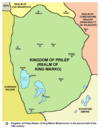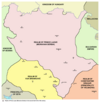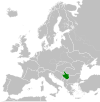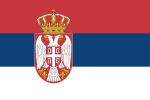The Chronicle of the Priest of Dioclea or Duklja is the usual name given to a purportedly medieval chronicle written in the late 13th century by an anonymous priest from Duklja. Its oldest preserved copy is in Latin from the 17th century, while it has been variously claimed by modern historians to have been compiled between the late 14th and early 16th centuries.
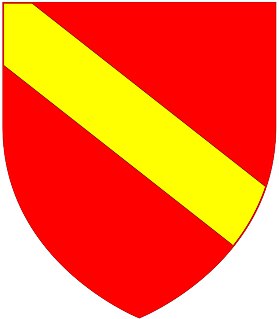
The Vojislavljević was a Serbian medieval dynasty, named after archon Stefan Vojislav, who wrested the polities of Duklja, Travunia, Zahumlje, inner Serbia and Bosnia from the Byzantines in the mid-11th century. His successors, kings Mihailo I Vojislavljević and Constantine Bodin expanded and consolidated the state. During the 12th century, the main line of the Vojislavljević family was ousted by their cadet branch, the Vukanović, in the late 12th century.
Dobroslav II was King of Duklja, between 1101 and 1102.

Kočapar was the knez or župan of Duklja, a Serbian state, briefly in 1102–03 under the suzerainty of Grand Prince Vukan of Rascia. He was the son of Branislav, the Prince of Duklja. Following Bodin's death in 1108, Bodin's half-brother Dobroslav II succeeded him as king of Doclea. Kočopar, Bodin's first cousin once removed, travelled from Dyrrhachium to Rascia, forging an alliance with Vukan. This alliance would prove worthy in their successful invasion of Duklja in 1102. The battle that ensued at the Morača led to the overthrow of Dobroslav II and the coronation of Kočapar to the throne. Dobroslav was subsequently banished to Rascia and a large part of Dalmatia was pillaged in the process. Vukan gave Kočapar Duklja as a fief. The two would soon brake, with Vukan, sending a squad to Doclea (city), forcing Kočapar to flee to Bosnia and then Zahumlje where he also died.

Vladimir II was King of Duklja from 1103 to 1113. He was a son of prince Vladimir, the oldest son of King Mihailo I of Duklja, and thus a nephew of King Constantine Bodin. He married a daughter of Vukan, the Grand Prince of Serbia, thereby ending rivalries between the two polities. Vladimir had been appointed the rule of Duklja by his father-in-law Vukan, after the death of his uncle, former King Kočopar, in Zahumlje. He was poisoned in 1118 on the orders of Queen-Dowager Jaquinta, the widow of his uncle, Constantine Bodin. Jaquinta soon appointed her son, George, to the throne.

George I of Duklja or Đorđe Vojislavljević was a King of Duklja from 1113 to 1118, and again from 1125 to 1131. He was a son of King Constantine Bodin, of the Vojislavljević dynasty.
Grubeša Branislavljević was Prince and ruler of Duklja from 1118 to 1125. After the Byzantine Empire defeated King George I of Duklja in 1118, Grubeša assumed the throne as a Byzantine protégé. The Byzantines entitled Grubeša the rule in Duklja, as well as providing him with an army that he would command against George, who was backed by the Grand Principality of Serbia under the rule of the Vukanović dynasty. Grubeša reigned until his death in 1125, when he was defeated by George. He is buried at the Church of Saint George in Bar.

Mihailo II was the King of Duklja from 1101 to 1102. He was the eldest son of King Constantine Bodin of Duklja and Queen Jaquinta. He succeeded his father on the throne of Duklja, but soon lost ground to cousins, pretenders to the throne. left without support, he abdicated and retreated to monastery.

Pomorje, also known as the Lands of Pomorje, is a medieval term, used to designate several maritime regions of Upper Dalmatia and its hinterland, that at the end of the 12th century, during the reign of Stefan Nemanja (1166–1196), became part of the Grand Principality of Serbia, and remained part of the medieval Kingdom of Serbia, whose rulers were styled with the title: "crowned king and autocrat of all Serbian and coastal lands".
The Vukanović dynasty, was a medieval Serbian dynasty that ruled over inner Serbia, centered in the Raška region, during the 11th and 12th century. Several members of the Vukanović dynasty also ruled in some other regions. The house may have descended from the Vojislavljević dynasty of Duklja. Vukanović dynasty was later succeeded in Serbia by the closely related Nemanjić dynasty.
Piva is a historical region in Montenegro, which existed as a tribe also known as Pivljani. It is situated in the northwestern highlands of Montenegro, bordering the Republika Srpska. The Piva river flows through the region. The regional center is the town of Plužine.

Prosigoj was a Serbian ruler believed to have ruled prior to c. 830. Serbia was a Slavic principality subject to the Byzantine Empire, located in the western Balkans, bordering with Bulgaria in the east. Mentioned in the De Administrando Imperio (DAI) from the mid-10th century, he succeeded his father Radoslav and was succeeded by his son Vlastimir.
Vukan I was the Grand Prince of Serbia from 1083 until his death in 1112. During first years. he ruled together with his brother Marko, holding the regions of inner Serbia. With the death of his cousin, king Constantine Bodin of Duklja in 1101, he became the most powerful ruler among Serbian princes. He defeated the Byzantines several times, conquering parts of northern Macedonia. He is the eponymous founder of the Vukanović dynasty.
Dragimir or Dragomir (Драгомир) was ruler of Travunia and Zachlumia, medieval Serbian principalities located in present-day regions of Herzegovina and south Dalmatia, from an unknown date before 1000 to 1018. The only preserved medieval source that mentions Dragimir is the dubious Chronicle of the Priest of Duklja, specifically its Chapters 34–37. Chapter 34 relates that "King" Chvalimir of the Belojević dynasty divided his domain among his sons, giving Zenta to his first-born Petrislav, Travunia and Zachlumia to Dragimir, and Podgoria to the youngest Miroslav. After Miroslav died without an heir, his land was taken over by Petrislav, who thus ruled all of Duklja. However this is contradictory to the earlier and more trusted De Administrando Imperio which states that Hvalimir's son was Čučimir, leaving up to question whether Dragimir was Hvalimir's grandson, or whether he existed at all. In 1009 or 1010, Bulgarian Emperor Samuel occupied Dragimir's lands, together with Duklja, Bosnia, and Raška. Dragimir retreated before the emperor's army on a mountain, but was soon invited by Samuel to come down and resume ruling Travunia and Zachlumia as his vassal. The emperor had previously made a similar arrangement in Duklja with Jovan Vladimir, son and successor of Petrislav. Vladimir was killed in 1016 by Samuel's son's successor Ivan Vladislav who was killed at the end of 1017.

According to the dubious Chronicle of the Priest of Duklja, a Magyar leader named Kisa led an invasion into Bosnia, where he was decisively defeated by Časlav, the Prince of Serbia, somewhere on the Drina. Kisa's widow requested from the Magyar chief to give her another army to avenge his death. With an "unknown number" of troops, the widow went for Časlav, encountering him somewhere in Syrmia. In the night, the Magyars attacked the Serbs, captured Časlav and all of his male relatives. On the command of the widow, all of them were bound by their hands and feet and thrown into the Sava river. Vladimir Ćorović dates this event to c. 960.
Beloje was the župan of Travunia some time in the first half of the 9th century. Travunia was a polity centered in Trebinje, subject to the Principality of Serbia. Mentioned in De Administrando Imperio (DAI) of Byzantine Emperor Constantine VII, Beloje was a contemporary of Serbian ruler Vlastimir. It is unknown how he came to the position; it might have been through the primogeniture principles, however, there is no definite answer. Vlastimir married his daughter to Beloje's son Krajina, and "desiring to ennoble his son-in-law", elevated his rank to archon (prince) and made him independent. Travunia was thus elevated from a župa into an archonty (principality), practically independent, while Vlastimir oversaw his son-in-law. T. Živković theorized that Beloje sought to free himself of Serbian rule, and that Vlastimir prevented this through a political marriage between the two families, possibly prior to the Bulgar–Serb War (839–842). Krajina's descendants were entitled the rule of Travunia under Serbian suzerainty.
The Catepanate of Ras was a province (catepanate) of the Byzantine Empire, established around 971 in central regions of early medieval Serbia, during the rule of Byzantine Emperor John Tzimiskes (969–976). The catepanate was named after the fortified town of Ras, eponymous for the historical region of Raška. The province was short lived, and collapsed soon after 976, following the Byzantine retreat from the region after the restoration of the Bulgarian Empire.
Tihomir of Raška was a Serbian nobleman, mentioned in the Chronicle of the Priest of Duklja, who served as the Grand Prince of Raška, from around 960 to 969.
Administrative divisions of medieval Serbia refer to regional administrative divisions of Medieval Serbia, from the 7th to the 15 the century.


















